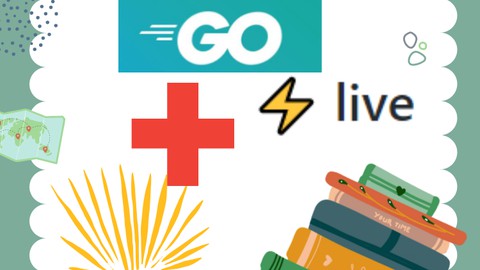
Mastering Live(View) development in Go (GoLang)
Mastering Live(View) development in Go (GoLang), available at $54.99, has an average rating of 4.4, with 36 lectures, 1 quizzes, based on 49 reviews, and has 9643 subscribers.
You will learn about Real-time user experiences with server-rendered HTML Phoenix(Elixir) LiveView-like programming in Go Form-based UI using Live(View) Pub/Sub based user communication using Live(View) Periodic background jobs using Live(View) Creating a single-page application in one file Integration with Fabric framework Handling application events in a declarative way Using websocket communication between frontend and backend This course is ideal for individuals who are For all existing or new Go programmers with an interest for LiveView like programming approach when building interactive applications easily. It is particularly useful for For all existing or new Go programmers with an interest for LiveView like programming approach when building interactive applications easily.
Enroll now: Mastering Live(View) development in Go (GoLang)
Summary
Title: Mastering Live(View) development in Go (GoLang)
Price: $54.99
Average Rating: 4.4
Number of Lectures: 36
Number of Quizzes: 1
Number of Published Lectures: 36
Number of Published Quizzes: 1
Number of Curriculum Items: 37
Number of Published Curriculum Objects: 37
Original Price: $94.99
Quality Status: approved
Status: Live
What You Will Learn
- Real-time user experiences with server-rendered HTML
- Phoenix(Elixir) LiveView-like programming in Go
- Form-based UI using Live(View)
- Pub/Sub based user communication using Live(View)
- Periodic background jobs using Live(View)
- Creating a single-page application in one file
- Integration with Fabric framework
- Handling application events in a declarative way
- Using websocket communication between frontend and backend
Who Should Attend
- For all existing or new Go programmers with an interest for LiveView like programming approach when building interactive applications easily.
Target Audiences
- For all existing or new Go programmers with an interest for LiveView like programming approach when building interactive applications easily.
Welcome to the ‘Mastering Live(View) programming in Go’ course. With this course, you will add value to your existing Go Lang knowledge by getting familiar with several web development techniques known as a ‘LiveView’ programming model introduced within the last several years.
We will focus on several topics popular when building web applications and we take a look at how to implement those features using Live(View) techniques where JS usage is not needed or minimized at least. We are going to see how the Live(View) programming approach makes web app development easier to do and more solution-oriented.
What you’ll learn
-
Create interactive web apps in GoLang
-
Use of websockets as a modern technique for client-server communication
-
Knowledge of creating UI based apps with your current GoLang backend skills
-
Use of Push techniques for updating users from backend
-
Create collaboration types of applications using popular LiveView approach
-
Speed-up your development with modern programming techniques
-
Create highly maintainable and easy to read application code
What is the LiveVew programming approach/model?
LiveView provides rich, real-time user experiences with server-rendered HTML. The LiveView programming model is mostly declarative: instead of saying “when event ABC happens, change XYZ on the page”, events in LiveView are managed by handlers bound to event id. Once the state changes, LiveView will re-render the relevant parts of its HTML template(calculate diff) and push it to the browser, which updates itself most efficiently. This means developers write LiveView templates as any other server-rendered HTML and LiveView does the hard work of tracking changes and sending the relevant diffs to the browser using websocket communication. Phoenix Framework widely popularized this approach and there are implementations for many significant languages or platforms.
Topics covered by this course:
During the course, we create a basic web application in Go Lang with a Live(View) approach. The main topics include:
-
LiveView-inspired programming – technical info
-
Key Live(View) concepts explained
-
Thermostat – interactive application without JS
-
Implementation of Pub/Sub communication
-
Enhancing thermostat – implementation of chat, clock, JS hooks
-
Live(View) in popular frameworks
-
Integration of Live(View) application with NATS server
An important part of this course is to realize ‘what we don’t need to do’ when using the Live(View) approach. Simplification can be huge and the old saying that ‘the best code is the code you don’t have to write’ is proven here.
Summary:
The goal of this course is to make a guide in the Live(View) programming world. We use a pragmatic approach by building real applications and exploring the Live(View) programming model practically.
GitHub repository:
The source code is available through the link attached to the last lecture in this course. You can clone the repo and use the code snippets we are building in this course.
Course Curriculum
Chapter 1: Introduction
Lecture 1: Introduction
Chapter 2: LiveView inspired programming – technical info
Lecture 1: Application communication flow
Lecture 2: Websocket as a horse power for your application
Chapter 3: Key Live(View) concepts explained
Lecture 1: Core minimum application structure
Lecture 2: Handling Events
Lecture 3: Using Params
Chapter 4: Thermostat – interactive application without JS
Lecture 1: Thermostat Feature Overview
Lecture 2: GoLang App – minimal setup
Lecture 3: Creating Live(View) application core
Lecture 4: Starting with Thermostat UI
Lecture 5: Mounting application to backend
Lecture 6: Side note: Where backend state is stored?
Lecture 7: Buttons and click events – part 1
Lecture 8: Buttons and click events – part 2
Lecture 9: What we are not doing?
Lecture 10: Getting and displaying the username
Lecture 11: Communicating the status to UI
Lecture 12: Overview
Chapter 5: Quiz
Chapter 6: Live with Pub/Sub – real-time communication
Lecture 1: Technical introduction
Lecture 2: Basic application setup updates
Lecture 3: Using Pub/Sub for communication for status updates
Lecture 4: Implementing status history updates
Lecture 5: What we are not doing
Chapter 7: Thermostat – adding a new features
Lecture 1: Adding a temperature warning
Lecture 2: Adding a clock
Lecture 3: Adding a chat like communication
Lecture 4: Working with custom JS using 'hooks'
Lecture 5: Managing temperature using a keyboard
Lecture 6: What we are not doing
Chapter 8: Live(View) with other popular frameworks
Lecture 1: Live(View) with Fiber Framework – part 1
Lecture 2: Live(View) with Fiber Framework – part 2
Lecture 3: Using Django compatible template engine
Chapter 9: Live(View) integration with NATS server (external Pub/Sub system or MQ)
Lecture 1: What is NATS Server
Lecture 2: Setting up an external NATS periodic message publisher
Lecture 3: NATS Go client setup
Lecture 4: Making a Live app receiving and displaying NATS data
Instructors
-
David Marko
developer/architect
Rating Distribution
- 1 stars: 1 votes
- 2 stars: 1 votes
- 3 stars: 1 votes
- 4 stars: 9 votes
- 5 stars: 37 votes
Frequently Asked Questions
How long do I have access to the course materials?
You can view and review the lecture materials indefinitely, like an on-demand channel.
Can I take my courses with me wherever I go?
Definitely! If you have an internet connection, courses on Udemy are available on any device at any time. If you don’t have an internet connection, some instructors also let their students download course lectures. That’s up to the instructor though, so make sure you get on their good side!
You may also like
- Best Investing Courses to Learn in March 2025
- Best Personal Finance Courses to Learn in March 2025
- Best Health And Wellness Courses to Learn in March 2025
- Best Chatgpt And Ai Tools Courses to Learn in March 2025
- Best Virtual Reality Courses to Learn in March 2025
- Best Augmented Reality Courses to Learn in March 2025
- Best Blockchain Development Courses to Learn in March 2025
- Best Unity Game Development Courses to Learn in March 2025
- Best Artificial Intelligence Courses to Learn in March 2025
- Best Flutter Development Courses to Learn in March 2025
- Best Docker Kubernetes Courses to Learn in March 2025
- Best Business Analytics Courses to Learn in March 2025
- Best Excel Vba Courses to Learn in March 2025
- Best Devops Courses to Learn in March 2025
- Best Angular Courses to Learn in March 2025
- Best Node Js Development Courses to Learn in March 2025
- Best React Js Courses to Learn in March 2025
- Best Cyber Security Courses to Learn in March 2025
- Best Machine Learning Courses to Learn in March 2025
- Best Ethical Hacking Courses to Learn in March 2025






















